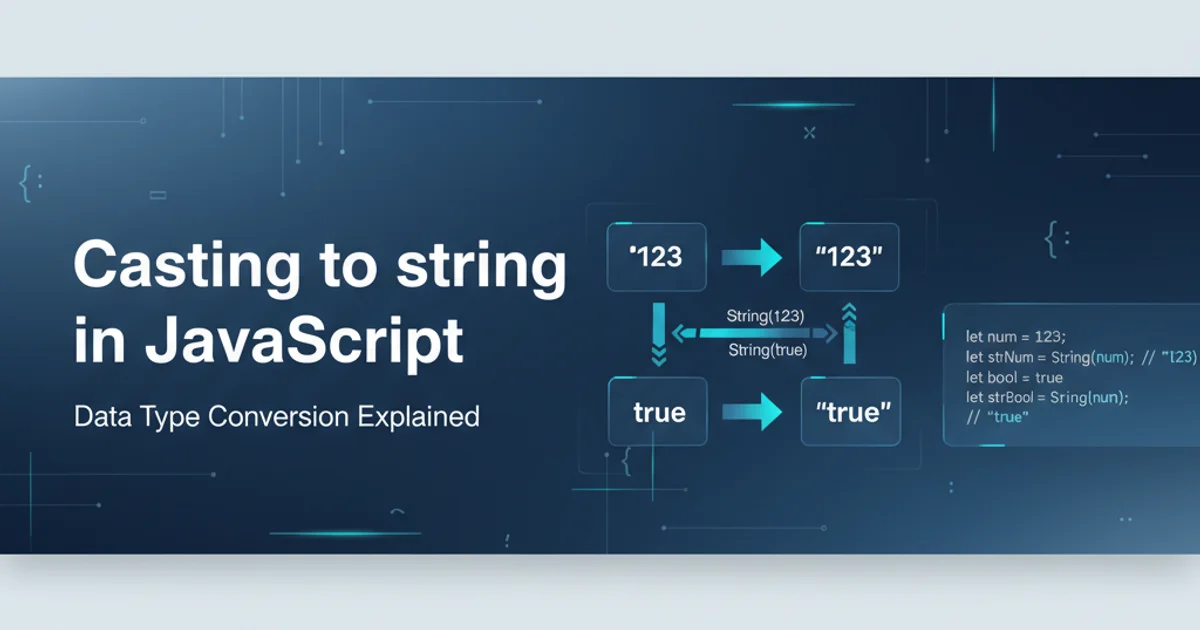Casting to string in JavaScript
Categories:
Mastering String Conversion in JavaScript

Explore various methods for casting values to strings in JavaScript, understanding their nuances, use cases, and potential pitfalls.
In JavaScript, converting a value to its string representation is a fundamental operation. Whether you're displaying data to a user, concatenating values, or serializing information for storage or transmission, understanding how to effectively cast to a string is crucial. This article delves into the primary methods available for string conversion, highlighting their behaviors with different data types and offering best practices.
Implicit vs. Explicit String Conversion
JavaScript often performs type coercion automatically, which can lead to implicit string conversion. While convenient, explicit conversion methods offer greater control and predictability. Understanding the difference is key to avoiding unexpected behavior in your code.
flowchart TD
A[Value] --> B{Operation Requires String?}
B -- Yes --> C[Implicit Conversion]
B -- No --> D[Original Type Used]
A --> E[Explicit Conversion Method]
E --> F[String Result]Flowchart illustrating implicit vs. explicit string conversion paths.
Implicit conversion typically occurs during operations like string concatenation using the + operator, or when a non-string value is passed to a function expecting a string (e.g., alert()). Explicit methods, on the other hand, involve directly calling functions or methods designed for type conversion, such as String(), .toString(), or template literals.
Common Methods for Explicit String Conversion
JavaScript provides several built-in mechanisms for explicitly converting values to strings. Each method has its own characteristics and is suitable for different scenarios.
1. The String() Global Function
The String() global function is a straightforward way to convert any value to its string representation. It works reliably across all data types, including null and undefined.
console.log(String(123)); // "123"
console.log(String(true)); // "true"
console.log(String(null)); // "null"
console.log(String(undefined)); // "undefined"
console.log(String({})); // "[object Object]"
console.log(String([1, 2, 3])); // "1,2,3"
Using the String() global function for various types.
2. The .toString() Method
Most JavaScript objects inherit a toString() method, which returns a string representation of the object. However, its behavior varies depending on the object type. Primitive values (numbers, booleans) also have a toString() method.
console.log((123).toString()); // "123"
console.log(true.toString()); // "true"
console.log({}.toString()); // "[object Object]"
console.log([1, 2, 3].toString()); // "1,2,3"
// Caution: .toString() on null or undefined throws an error
// console.log(null.toString()); // TypeError: Cannot read properties of null (reading 'toString')
// console.log(undefined.toString()); // TypeError: Cannot read properties of undefined (reading 'toString')
Examples of .toString() and its limitations.
.toString() with null or undefined, as it will throw a TypeError. The String() global function is safer for unknown or potentially null/undefined values.3. Template Literals (Template Strings)
Template literals, introduced in ES6, provide a convenient and readable way to embed expressions within string literals. Any expression inside ${} will be implicitly converted to a string.
const num = 42;
const bool = false;
const obj = { id: 1 };
console.log(`The number is ${num}.`); // "The number is 42."
console.log(`The boolean is ${bool}.`); // "The boolean is false."
console.log(`The object is ${obj}.`); // "The object is [object Object]."
console.log(`Null value: ${null}.`); // "Null value: null."
console.log(`Undefined value: ${undefined}.`); // "Undefined value: undefined."
Using template literals for string conversion and interpolation.
null and undefined.Special Cases and Considerations
While the above methods cover most scenarios, certain data types and situations warrant special attention.
Objects and Arrays
When converting objects and arrays to strings, the default toString() behavior often yields "[object Object]" for plain objects and a comma-separated list for arrays. For more meaningful string representations, especially for debugging or serialization, JSON.stringify() is often a better choice.
const myObject = { name: 'Alice', age: 30 };
const myArray = [10, 20, { key: 'value' }];
console.log(String(myObject)); // "[object Object]"
console.log(myObject.toString()); // "[object Object]"
console.log(JSON.stringify(myObject)); // "{"name":"Alice","age":30}"
console.log(String(myArray)); // "10,20,[object Object]"
console.log(myArray.toString()); // "10,20,[object Object]"
console.log(JSON.stringify(myArray)); // "[10,20,{"key":"value"}]"
Comparing String(), .toString(), and JSON.stringify() for objects and arrays.
JSON.stringify() provides a much more informative string representation than the default toString().Numbers with Radix
The Number.prototype.toString() method can accept an optional radix argument, allowing you to convert a number to a string in a specified base (e.g., binary, hexadecimal).
const decimalNum = 255;
console.log(decimalNum.toString()); // "255" (base 10)
console.log(decimalNum.toString(16)); // "ff" (base 16 - hexadecimal)
console.log(decimalNum.toString(2)); // "11111111" (base 2 - binary)
console.log(decimalNum.toString(8)); // "377" (base 8 - octal)
Using toString() with a radix for number base conversion.
Choosing the Right Method
The best method for string conversion depends on the context and the type of value you are converting.
1. For general-purpose conversion, especially with unknown types or potential null/undefined values
Use the String() global function. It's the safest and most consistent.
2. For primitive values (numbers, booleans) where you are certain they are not null or undefined
The .toString() method is concise and effective. For numbers, it also offers radix conversion.
3. For embedding variables and expressions within strings, or for building complex strings
Template literals (``) offer superior readability and convenience.
4. For serializing objects or arrays into a JSON string format
Use JSON.stringify(). This is essential for data transmission or storage.